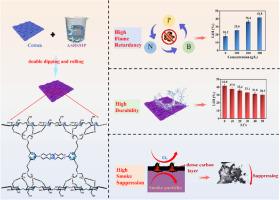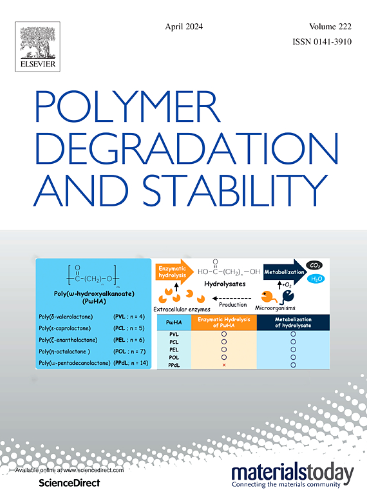一种基于膦酸铵的合成双三嗪环衍生物,用于棉织物的持久阻燃改性
IF 6.3
2区 化学
Q1 POLYMER SCIENCE
引用次数: 0
摘要
棉花在日常生活中被广泛使用。然而,其易燃性限制了它在某些领域的应用。本研究成功合成了一种新型无甲醛反应型阻燃剂 ASBSMP,它来自双三嗪环膦酸铵。ASBSMP/cotton 具有优异的阻燃性能,具有自熄特性,其限氧指数(LOI)为 41.8%。即使经过 50 次洗涤后,LOI 仍保持在 30.3 % 的高水平,显示出出色的耐久性。热重分析(TGA)显示了其卓越的热稳定性。锥形量热仪测试进一步证实了经过处理的棉花具有优异的阻燃性,与纯棉相比,总放热量(THR)降低了 44.6%,峰值放热率(PHRR)降低了 90.1%。傅立叶变换红外光谱(FTIR)、X 射线光电子能谱(XPS)和焦渣分析结果表明,ASBSMP 在气相和凝结相中都具有阻燃活性。ASBSMP/cotton 具有出色的机械完整性,可广泛应用于各种领域。本文章由计算机程序翻译,如有差异,请以英文原文为准。

A synthetic bis-triazine ring derivative based on ammonium phosphonate towards durable flame-retardant modification of cotton fabrics
Cotton is widely used in daily life. However, its flammability limits its application in certain areas. In this study, a novel formaldehyde-free reactive flame retardant, ASBSMP, derived from a bis-triazine ring ammonium phosphonate, was successfully synthesized. The ASBSMP/cotton exhibited excellent flame-retardant properties, with self-extinguishing characteristics and a LIMITING OXYGEN INDEX (LOI) of 41.8 %. Even after 50 washing cycles, the LOI remained at a high level of 30.3 %, indicating outstanding durability. Thermogravimetric analysis (TGA) revealed its superior thermal stability. Cone calorimeter tests further confirmed the superior flame retardancy of the treated cotton, showing a 44.6 % reduction in total heat release (THR) and a 90.1 % reduction in peak heat release rate (PHRR) compared to pure cotton. Results from Fourier Transform Infrared Spectroscopy (FTIR), X-ray Photoelectron Spectroscopy (XPS), and char residue analyses demonstrated that ASBSMP exhibited flame-retardant activity in both the gas and condensed phases. ASBSMP/cotton exhibited outstanding mechanical integrity for a wide range of applications.
求助全文
通过发布文献求助,成功后即可免费获取论文全文。
去求助
来源期刊

Polymer Degradation and Stability
化学-高分子科学
CiteScore
10.10
自引率
10.20%
发文量
325
审稿时长
23 days
期刊介绍:
Polymer Degradation and Stability deals with the degradation reactions and their control which are a major preoccupation of practitioners of the many and diverse aspects of modern polymer technology.
Deteriorative reactions occur during processing, when polymers are subjected to heat, oxygen and mechanical stress, and during the useful life of the materials when oxygen and sunlight are the most important degradative agencies. In more specialised applications, degradation may be induced by high energy radiation, ozone, atmospheric pollutants, mechanical stress, biological action, hydrolysis and many other influences. The mechanisms of these reactions and stabilisation processes must be understood if the technology and application of polymers are to continue to advance. The reporting of investigations of this kind is therefore a major function of this journal.
However there are also new developments in polymer technology in which degradation processes find positive applications. For example, photodegradable plastics are now available, the recycling of polymeric products will become increasingly important, degradation and combustion studies are involved in the definition of the fire hazards which are associated with polymeric materials and the microelectronics industry is vitally dependent upon polymer degradation in the manufacture of its circuitry. Polymer properties may also be improved by processes like curing and grafting, the chemistry of which can be closely related to that which causes physical deterioration in other circumstances.
 求助内容:
求助内容: 应助结果提醒方式:
应助结果提醒方式:


